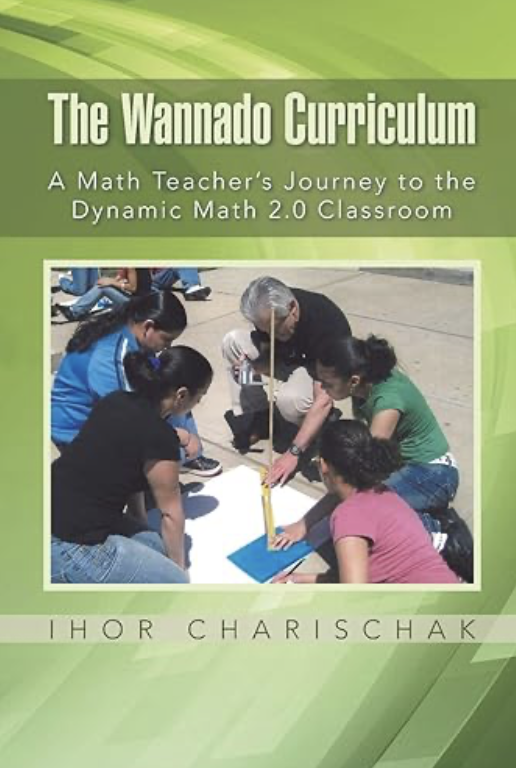
It’s entirely possible to fall in love with mathematics if the context is right, like the ”perfect storm,” where all the elements come together. Beyond the day-to-day usefulness of math, mathematics can be dynamic, fascinating, and empowering. Intrinsic motivation should drive learning. The math curriculum should be open-ended and allow for student and teacher creative flairs. There is a place for teachers and students to be partners in their learning enterprise, so that creating stories can bring a new life to what students would otherwise say is boring. Weaving other subjects into the teaching of math is an incredibly powerful way to engage student imagination and help them to see math’s relevance to the real world. It’s fine to be able to solve an algebraic equation, but if students have no idea what it’s used for in the real world, then what’s the point? Without a context, it’s just “mental gymnastics.” You don’t have to go far to see the math in history, science, music, and art. The list is endless. Currently, story-based learning adventures are not part of most math curriculums. The focus remains on the “haftado” curriculum (e.g., passing through all the gates on the royal road to calculus, where rewards are mostly extrinsic). However, one can invent—or better yet, reinvent—mathematics. The shift from a “haftado” to a “wannado” curriculum does not need to deprive students of the basic skills they need to be successful. Rather, it provides the perfect context for understanding the relevancy of those skills and the motivation to learn them. If kids “wannado” the projects, they will learn whatever hard stuff they encounter in order to accomplish their project’s goals … just as they do when they play video games.
We, as a math community, need to develop alternative routes for students with unique needs and skills. Technology opens the door for a whole host of alternatives. To keep the focus on math, it is imperative that technology be integral to the curriculum, rather than integrated. This is a subtle but important distinction, because technology-based microworlds empower students to focus on getting to know powerful mathematical ideas seamlessly. I firmly believe that technology can transform teaching and learning environments and help students achieve beyond what is possible without it.
So I end where I began. I think often about the times that I splashed in the water with my family at my side in Presque Isle, the joy it brought me, and how my anticipation of travel was so thoroughly engaging.
I loved to travel, and in the process, maps became my very first “microworld,” where I could passionately explore images, sights, sounds, and conversations in my imagination as new territories emerged through the window of my car. As I grew older these passions took new forms. The GPS enhanced my ability to travel. (Route 66 has become a passion, and I hope someday to drive the full route from Chicago to Santa Monica.)
Not all my youthful attempts realized their potential. Different levels of “want to do” had different outcomes. I did, to some extent, want to do (in contrast to “wannado”) my math homework, mostly because I was good at it, thanks to baseball, Stan Musial, and earned run averages, and I wanted to maintain my status as an elite student in the eyes of my teachers.
Growing up, I tried my hand at many different hobbies, but they all included some form of practice. I learned very quickly that if I didn’t like the activity, I hated practicing.
Of all these pursuits, however, it was playing baseball that eventually paid dividends. Because I loved it, I would practice until my joints hurt. I devoured baseball cards, memorizing hundreds of players’ statistics—amazing for someone who hated memorizing lines in acting class. (Context, anyone?) When I started playing simulated games and needed to bring Stan Musial’s statistics to life, I learned all about proportional reasoning, which helped to catapult me to the head of the math class. I held my status throughout high school, because the pedestrian school math came easily to me. It took a dose of college math for me to realize that I didn’t have the passion needed to be a real mathematician. It was after I started teaching math that I fell in love with learning math, and I couldn’t wait to share what I was learning with my students. The 1970s were a good time for discovering and exploring math with children. I was determined to become the best possible teacher I could be. I found a niche, first with students and then with teachers, where I could help them in ways that made a difference in their perceptions about mathematics. To this day, I still get e-mails from former students, thanking me for the help I gave them.
Even though I’m retired from teaching students and helping teachers, my vision of learning math in unique ways is still alive, still interesting, and still empowering for me. I firmly believe that if students delve into adventures that help them appreciate math, they too will find it interesting, useful, and even empowering.
As I continue to travel along my life path, I experience dynamic classrooms where I’m still learning and teaching, but now it’s in the context of my family, especially with my wife, Joan, my friends, and the travel that I share with them.
Whatever your passions in life, I hope this book inspires you to bring your own life experiences and passions into your dynamic classrooms. I encourage you to create wannado activities with the young people in your life, so they too can become passionate about learning.
For more information on my book, click on image below. Also if you wish to subscribe to this blog send me an email to: ihor@dmcpress.org
